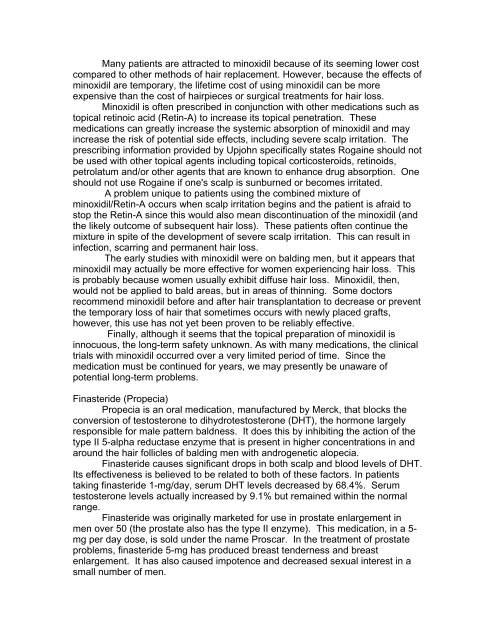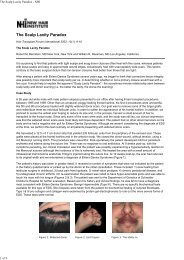The Patient's Guide to Hair Restoration - New Hair Institute
The Patient's Guide to Hair Restoration - New Hair Institute
The Patient's Guide to Hair Restoration - New Hair Institute
You also want an ePaper? Increase the reach of your titles
YUMPU automatically turns print PDFs into web optimized ePapers that Google loves.
Many patients are attracted <strong>to</strong> minoxidil because of its seeming lower cost<br />
compared <strong>to</strong> other methods of hair replacement. However, because the effects of<br />
minoxidil are temporary, the lifetime cost of using minoxidil can be more<br />
expensive than the cost of hairpieces or surgical treatments for hair loss.<br />
Minoxidil is often prescribed in conjunction with other medications such as<br />
<strong>to</strong>pical retinoic acid (Retin-A) <strong>to</strong> increase its <strong>to</strong>pical penetration. <strong>The</strong>se<br />
medications can greatly increase the systemic absorption of minoxidil and may<br />
increase the risk of potential side effects, including severe scalp irritation. <strong>The</strong><br />
prescribing information provided by Upjohn specifically states Rogaine should not<br />
be used with other <strong>to</strong>pical agents including <strong>to</strong>pical corticosteroids, retinoids,<br />
petrolatum and/or other agents that are known <strong>to</strong> enhance drug absorption. One<br />
should not use Rogaine if one's scalp is sunburned or becomes irritated.<br />
A problem unique <strong>to</strong> patients using the combined mixture of<br />
minoxidil/Retin-A occurs when scalp irritation begins and the patient is afraid <strong>to</strong><br />
s<strong>to</strong>p the Retin-A since this would also mean discontinuation of the minoxidil (and<br />
the likely outcome of subsequent hair loss). <strong>The</strong>se patients often continue the<br />
mixture in spite of the development of severe scalp irritation. This can result in<br />
infection, scarring and permanent hair loss.<br />
<strong>The</strong> early studies with minoxidil were on balding men, but it appears that<br />
minoxidil may actually be more effective for women experiencing hair loss. This<br />
is probably because women usually exhibit diffuse hair loss. Minoxidil, then,<br />
would not be applied <strong>to</strong> bald areas, but in areas of thinning. Some doc<strong>to</strong>rs<br />
recommend minoxidil before and after hair transplantation <strong>to</strong> decrease or prevent<br />
the temporary loss of hair that sometimes occurs with newly placed grafts,<br />
however, this use has not yet been proven <strong>to</strong> be reliably effective.<br />
Finally, although it seems that the <strong>to</strong>pical preparation of minoxidil is<br />
innocuous, the long-term safety unknown. As with many medications, the clinical<br />
trials with minoxidil occurred over a very limited period of time. Since the<br />
medication must be continued for years, we may presently be unaware of<br />
potential long-term problems.<br />
Finasteride (Propecia)<br />
Propecia is an oral medication, manufactured by Merck, that blocks the<br />
conversion of tes<strong>to</strong>sterone <strong>to</strong> dihydrotes<strong>to</strong>sterone (DHT), the hormone largely<br />
responsible for male pattern baldness. It does this by inhibiting the action of the<br />
type II 5-alpha reductase enzyme that is present in higher concentrations in and<br />
around the hair follicles of balding men with androgenetic alopecia.<br />
Finasteride causes significant drops in both scalp and blood levels of DHT.<br />
Its effectiveness is believed <strong>to</strong> be related <strong>to</strong> both of these fac<strong>to</strong>rs. In patients<br />
taking finasteride 1-mg/day, serum DHT levels decreased by 68.4%. Serum<br />
tes<strong>to</strong>sterone levels actually increased by 9.1% but remained within the normal<br />
range.<br />
Finasteride was originally marketed for use in prostate enlargement in<br />
men over 50 (the prostate also has the type II enzyme). This medication, in a 5mg<br />
per day dose, is sold under the name Proscar. In the treatment of prostate<br />
problems, finasteride 5-mg has produced breast tenderness and breast<br />
enlargement. It has also caused impotence and decreased sexual interest in a<br />
small number of men.



